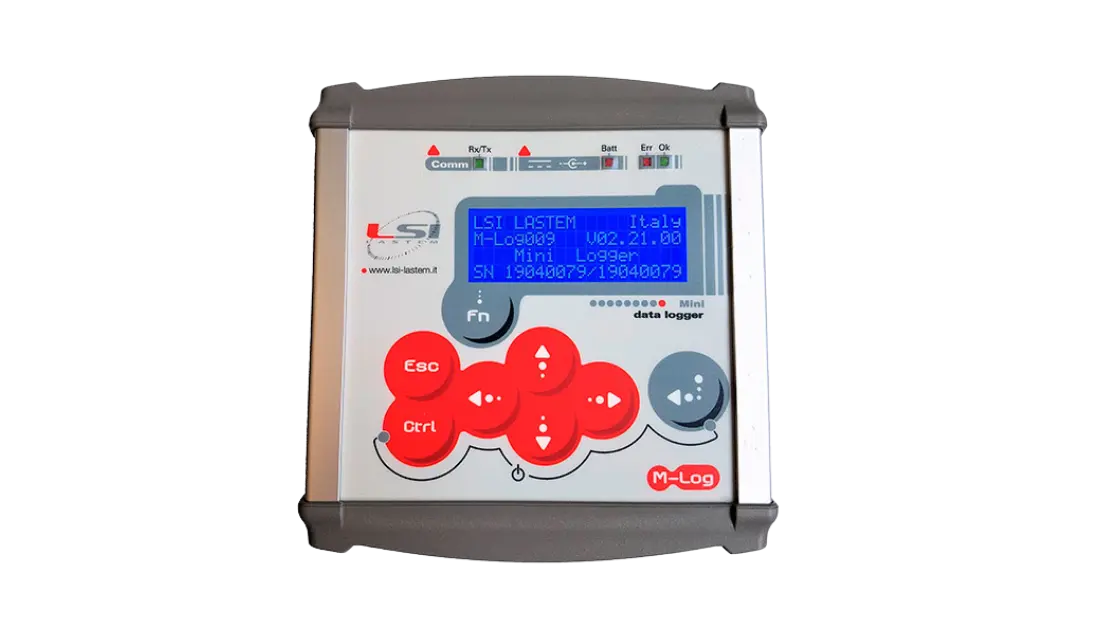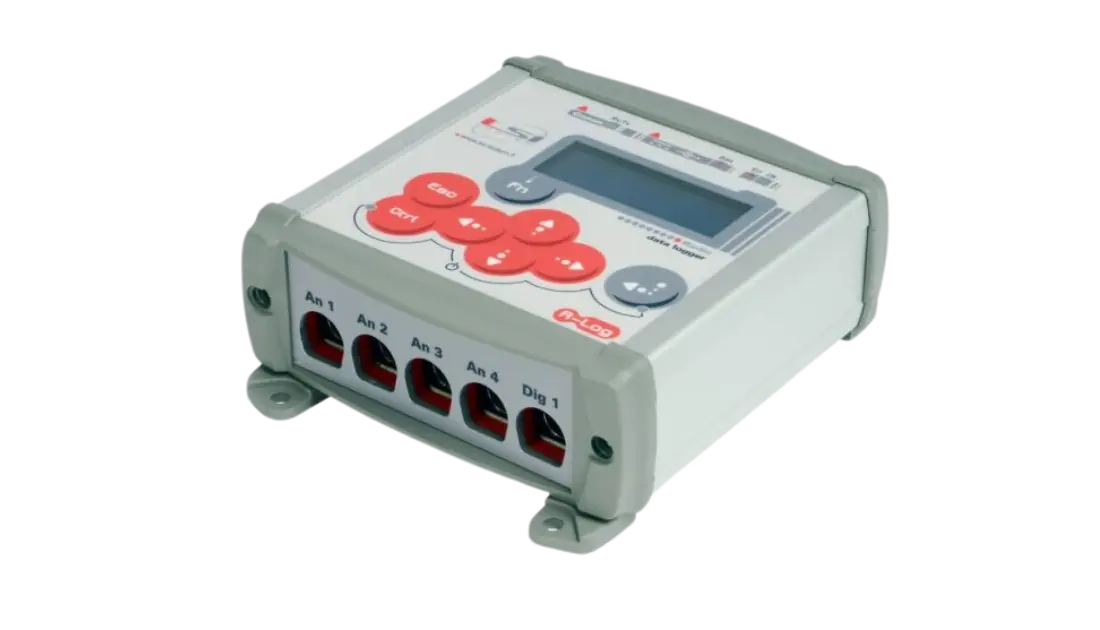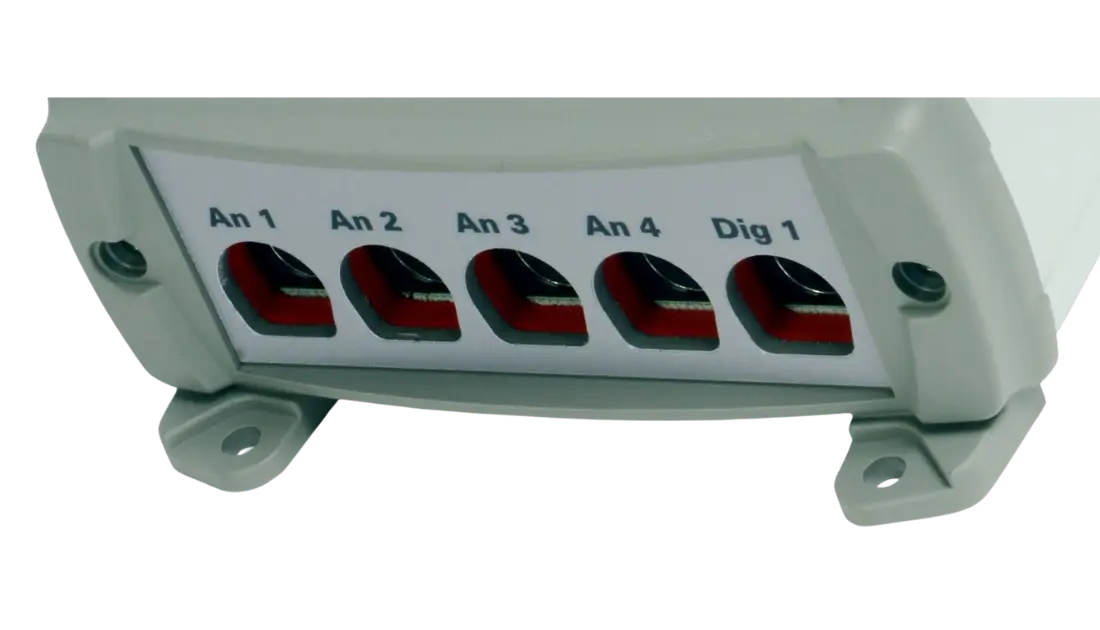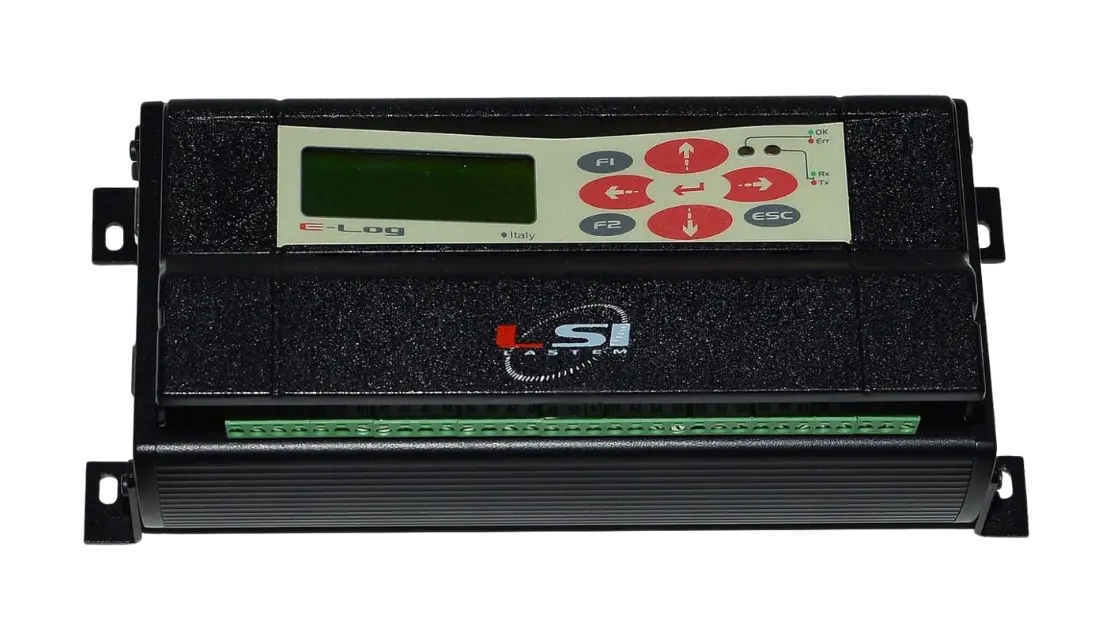M-Log
The compact and versatile data logger
M-Log is a line of compact data loggers for environmental monitoring, suitable for portable indoor applications. Small and flexible, but also powerful and reliable.
Typically M-Log (ELO009) is used on a portable tripod for Thermal Environmental measurements for the assessment of thermal comfort and stress, air quality, ventilation measurements, thermo-hygrometric measurements for assessing the energy efficiency of buildings and HVAC tests.
M-Log
Highlights
- N.4 analog inputs, n. 1 digital input, n. 1 RS232 Input;
- Auto-recognition of connected sensors;
- Input for serial sensors;
- Extremely low power consumption and integrated batteries;
- N. 50 measurements between channels for sensor acquisition and derived quantities;
- Internal library for calculating derived quantities and mathematical, statistical calculations;
- 8 MB Flash Memory;
- Modbus-RTU Master/Slave, TTY protocols;
- N. 2 RS232 ports;
- Sensors acquisition rate from 1 s to 12 hours;
- Statistic elaboration rate from 1 s to 12 hours;
- Connection to the PC via RS232 (USB/Ethernet with external accessories);
- Display and keyboard;
- Model code: ELO009.
Other Highlights
Inputs for serial sensors
The M-Log COM-2 port can be connected to hot wire anemometers or to sensors with Modbus-RTU protocol output.
Sensors acquisition rate
Acquisition rate is programmable for each input (from 1 sec to 12 hours). M-Log manages 4 channels from analog inputs and 8 derived quantities in 1 sec. To limit energy consumption from sensors requiring power supply, it is possible to set an advanced power supply from the acquisition event (warm-up), that is interrupted immediately after the acquisition itself.
Data elaboration
The raw measured values can be stored directly as instantaneous values, or be stored as statistical processing (n. 1 base, form 1 sec to 12 hours);
- Average, minimum, maximum, standard deviation;
- Wind elaborations;
- Totals.
Derived and calculated quantities
Internal library of derived environmental quantities. These calculations use acquired quantities, constant values and other calculated quantities. The library also includes mathematical functions. M-Log manages up to 50 channels between acquired, derived and calculated quantities.
Data memory
Internal memory (8MB) allows to store data typically for several weeks. The registration structure is circular. In the model (ELO009) with MiniDIN inputs the data is stored in “surveys” with progressive numbering and data/time start/end.
Data communication
It is possible to transfer data to a PC via RS232, USB (with adapter included), or via Ethernet through an external converter. M-Log uses a proprietary binary protocol to transmit data using LSI LASTEM communication programs: 3DOM and CommNET.
Measurements
M-Log units can be connected to a wide range of sensors for environmental quantities, as:
- Air Temperature and Relative Humidity;
- Black globe Temperature;
- Wet Temperature;
- Surface and materials Temperatures;
- Air Speed;
- Light;
- Pollution (IAQ);
- Thermal Flow and Radiant Asymmetry.
LSI LASTEM supplies a wide range of compatible sensors, read the LSI LASTEM catalogs.
Derived Quantities
LSI LASTEM data loggers have an internal library of formulas for calculating a series of environmental quantities. These quantities are obtained from measured parameters, entered by the operator and other calculated quantities.
- Absolute Humidity (VDI3786 Part 4);
- Air Changes (1997 Ashrae Fundamentals Handbook);
- Air Flow (1997 Ashrae Fundamentals Handbook);
- Air Speed (using Pitot and Darcy Tubes)
- Absolute Pressure (sea level);
- Dew Point (ISO7726);
- Heat Index;
- Evaporation;
- Mean Radiant Temperature (ISO7726);
- Radiant Temperature Asymmetry (ISO7726);
- Operative Temperature (ISO7726);
- Plane Radiant Temperature 1&2 (ISO7726);
- Partial vapor Pressure;
- Psychrometric Humidity (ISO7726);
- Specific Humidity (VDI3786 Part 4);
- Sunshine Duration;
- TCH – Chill Temperature (ISO TR11079);
- Wet Bulb Temperature (ISO7726);
- UV Exposition;
- UV Index;
- Wind Chill Index (ISO TR11079) – ELO008, ELO009;
- WBGT Index IN+OUT Formulas (ISO7243) – ELO008, ELO009;
- % dissatisfied by Floor Temperature (ISO7730) – ELO009;
- % dissatisfied by Vertical Temperature (ISO7730) – ELO009;
- % dissatisfied by Radiant Asymmetry (ISO7730) – ELO009;
- % dissatisfied by Air Draw (ISO7730) – ELO009;
- Daylight Factor (IESNA Lighting Handbook) – ELO009;
- Light Intensity (IESNA Lighting Handbook) – ELO009;
- Estimated Natural Decay of SARS-CoV-2 on Surfaces – ELO008, ELO009;
Documents
- DATA SHEETS
- MANUALS
- SCHEMATIC DRAWINGS
- CE
- Description
- Additional information
- Reviews (0)
- DECLARATION OF CONFORMITY
This document is not available for download, please contact our Sales Department.
Description
M-Log
Highlights
- N.4 analog inputs, n. 1 digital input, n. 1 RS232 Input;
- Auto-recognition of connected sensors;
- Input for serial sensors;
- Extremely low power consumption and integrated batteries;
- N. 50 measurements between channels for sensor acquisition and derived quantities;
- Internal library for calculating derived quantities and mathematical, statistical calculations;
- 8 MB Flash Memory;
- Modbus-RTU Master/Slave, TTY protocols;
- N. 2 RS232 ports;
- Sensors acquisition rate from 1 s to 12 hours;
- Statistic elaboration rate from 1 s to 12 hours;
- Connection to the PC via RS232 (USB/Ethernet with external accessories);
- Display and keyboard;
- Model code: ELO009.
Other Highlights
Inputs for serial sensors
The M-Log COM-2 port can be connected to hot wire anemometers or to sensors with Modbus-RTU protocol output.
Sensors acquisition rate
Acquisition rate is programmable for each input (from 1 sec to 12 hours). M-Log manages 4 channels from analog inputs and 8 derived quantities in 1 sec. To limit energy consumption from sensors requiring power supply, it is possible to set an advanced power supply from the acquisition event (warm-up), that is interrupted immediately after the acquisition itself.
Data elaboration
The raw measured values can be stored directly as instantaneous values, or be stored as statistical processing (n. 1 base, form 1 sec to 12 hours);
- Average, minimum, maximum, standard deviation;
- Wind elaborations;
- Totals.
Derived and calculated quantities
Internal library of derived environmental quantities. These calculations use acquired quantities, constant values and other calculated quantities. The library also includes mathematical functions. M-Log manages up to 50 channels between acquired, derived and calculated quantities.
Data memory
Internal memory (8MB) allows to store data typically for several weeks. The registration structure is circular. In the model (ELO009) with MiniDIN inputs the data is stored in “surveys” with progressive numbering and data/time start/end.
Data communication
It is possible to transfer data to a PC via RS232, USB (with adapter included), or via Ethernet through an external converter. M-Log uses a proprietary binary protocol to transmit data using LSI LASTEM communication programs: 3DOM and CommNET.
Measurements
M-Log units can be connected to a wide range of sensors for environmental quantities, as:
- Air Temperature and Relative Humidity;
- Black globe Temperature;
- Wet Temperature;
- Surface and materials Temperatures;
- Air Speed;
- Light;
- Pollution (IAQ);
- Thermal Flow and Radiant Asymmetry.
LSI LASTEM supplies a wide range of compatible sensors, read the LSI LASTEM catalogs.
Derived Quantities
LSI LASTEM data loggers have an internal library of formulas for calculating a series of environmental quantities. These quantities are obtained from measured parameters, entered by the operator and other calculated quantities.
- Absolute Humidity (VDI3786 Part 4);
- Air Changes (1997 Ashrae Fundamentals Handbook);
- Air Flow (1997 Ashrae Fundamentals Handbook);
- Air Speed (using Pitot and Darcy Tubes)
- Absolute Pressure (sea level);
- Dew Point (ISO7726);
- Heat Index;
- Evaporation;
- Mean Radiant Temperature (ISO7726);
- Radiant Temperature Asymmetry (ISO7726);
- Operative Temperature (ISO7726);
- Plane Radiant Temperature 1&2 (ISO7726);
- Partial vapor Pressure;
- Psychrometric Humidity (ISO7726);
- Specific Humidity (VDI3786 Part 4);
- Sunshine Duration;
- TCH – Chill Temperature (ISO TR11079);
- Wet Bulb Temperature (ISO7726);
- UV Exposition;
- UV Index;
- Wind Chill Index (ISO TR11079) – ELO008, ELO009;
- WBGT Index IN+OUT Formulas (ISO7243) – ELO008, ELO009;
- % dissatisfied by Floor Temperature (ISO7730) – ELO009;
- % dissatisfied by Vertical Temperature (ISO7730) – ELO009;
- % dissatisfied by Radiant Asymmetry (ISO7730) – ELO009;
- % dissatisfied by Air Draw (ISO7730) – ELO009;
- Daylight Factor (IESNA Lighting Handbook) – ELO009;
- Light Intensity (IESNA Lighting Handbook) – ELO009;
- Estimated Natural Decay of SARS-CoV-2 on Surfaces – ELO008, ELO009;
Additional information
| Applications | Energy testing of buildings, IEQ and environmental comfort, Museums and archaeological sites, Stress and thermal comfort and related quantities portable |
|---|
- DATA SHEETS
- MANUALS
- SCHEMATIC DRAWINGS
- CE
- Description
- Additional information
- Reviews (0)
- DECLARATION OF CONFORMITY
This document is not available for download, please contact our Sales Department.
Description
M-Log
Highlights
- N.4 analog inputs, n. 1 digital input, n. 1 RS232 Input;
- Auto-recognition of connected sensors;
- Input for serial sensors;
- Extremely low power consumption and integrated batteries;
- N. 50 measurements between channels for sensor acquisition and derived quantities;
- Internal library for calculating derived quantities and mathematical, statistical calculations;
- 8 MB Flash Memory;
- Modbus-RTU Master/Slave, TTY protocols;
- N. 2 RS232 ports;
- Sensors acquisition rate from 1 s to 12 hours;
- Statistic elaboration rate from 1 s to 12 hours;
- Connection to the PC via RS232 (USB/Ethernet with external accessories);
- Display and keyboard;
- Model code: ELO009.
Other Highlights
Inputs for serial sensors
The M-Log COM-2 port can be connected to hot wire anemometers or to sensors with Modbus-RTU protocol output.
Sensors acquisition rate
Acquisition rate is programmable for each input (from 1 sec to 12 hours). M-Log manages 4 channels from analog inputs and 8 derived quantities in 1 sec. To limit energy consumption from sensors requiring power supply, it is possible to set an advanced power supply from the acquisition event (warm-up), that is interrupted immediately after the acquisition itself.
Data elaboration
The raw measured values can be stored directly as instantaneous values, or be stored as statistical processing (n. 1 base, form 1 sec to 12 hours);
- Average, minimum, maximum, standard deviation;
- Wind elaborations;
- Totals.
Derived and calculated quantities
Internal library of derived environmental quantities. These calculations use acquired quantities, constant values and other calculated quantities. The library also includes mathematical functions. M-Log manages up to 50 channels between acquired, derived and calculated quantities.
Data memory
Internal memory (8MB) allows to store data typically for several weeks. The registration structure is circular. In the model (ELO009) with MiniDIN inputs the data is stored in “surveys” with progressive numbering and data/time start/end.
Data communication
It is possible to transfer data to a PC via RS232, USB (with adapter included), or via Ethernet through an external converter. M-Log uses a proprietary binary protocol to transmit data using LSI LASTEM communication programs: 3DOM and CommNET.
Measurements
M-Log units can be connected to a wide range of sensors for environmental quantities, as:
- Air Temperature and Relative Humidity;
- Black globe Temperature;
- Wet Temperature;
- Surface and materials Temperatures;
- Air Speed;
- Light;
- Pollution (IAQ);
- Thermal Flow and Radiant Asymmetry.
LSI LASTEM supplies a wide range of compatible sensors, read the LSI LASTEM catalogs.
Derived Quantities
LSI LASTEM data loggers have an internal library of formulas for calculating a series of environmental quantities. These quantities are obtained from measured parameters, entered by the operator and other calculated quantities.
- Absolute Humidity (VDI3786 Part 4);
- Air Changes (1997 Ashrae Fundamentals Handbook);
- Air Flow (1997 Ashrae Fundamentals Handbook);
- Air Speed (using Pitot and Darcy Tubes)
- Absolute Pressure (sea level);
- Dew Point (ISO7726);
- Heat Index;
- Evaporation;
- Mean Radiant Temperature (ISO7726);
- Radiant Temperature Asymmetry (ISO7726);
- Operative Temperature (ISO7726);
- Plane Radiant Temperature 1&2 (ISO7726);
- Partial vapor Pressure;
- Psychrometric Humidity (ISO7726);
- Specific Humidity (VDI3786 Part 4);
- Sunshine Duration;
- TCH – Chill Temperature (ISO TR11079);
- Wet Bulb Temperature (ISO7726);
- UV Exposition;
- UV Index;
- Wind Chill Index (ISO TR11079) – ELO008, ELO009;
- WBGT Index IN+OUT Formulas (ISO7243) – ELO008, ELO009;
- % dissatisfied by Floor Temperature (ISO7730) – ELO009;
- % dissatisfied by Vertical Temperature (ISO7730) – ELO009;
- % dissatisfied by Radiant Asymmetry (ISO7730) – ELO009;
- % dissatisfied by Air Draw (ISO7730) – ELO009;
- Daylight Factor (IESNA Lighting Handbook) – ELO009;
- Light Intensity (IESNA Lighting Handbook) – ELO009;
- Estimated Natural Decay of SARS-CoV-2 on Surfaces – ELO008, ELO009;
Additional information
| Applications | Energy testing of buildings, IEQ and environmental comfort, Museums and archaeological sites, Stress and thermal comfort and related quantities portable |
|---|
Reviews
There are no reviews yet.






Reviews
There are no reviews yet.